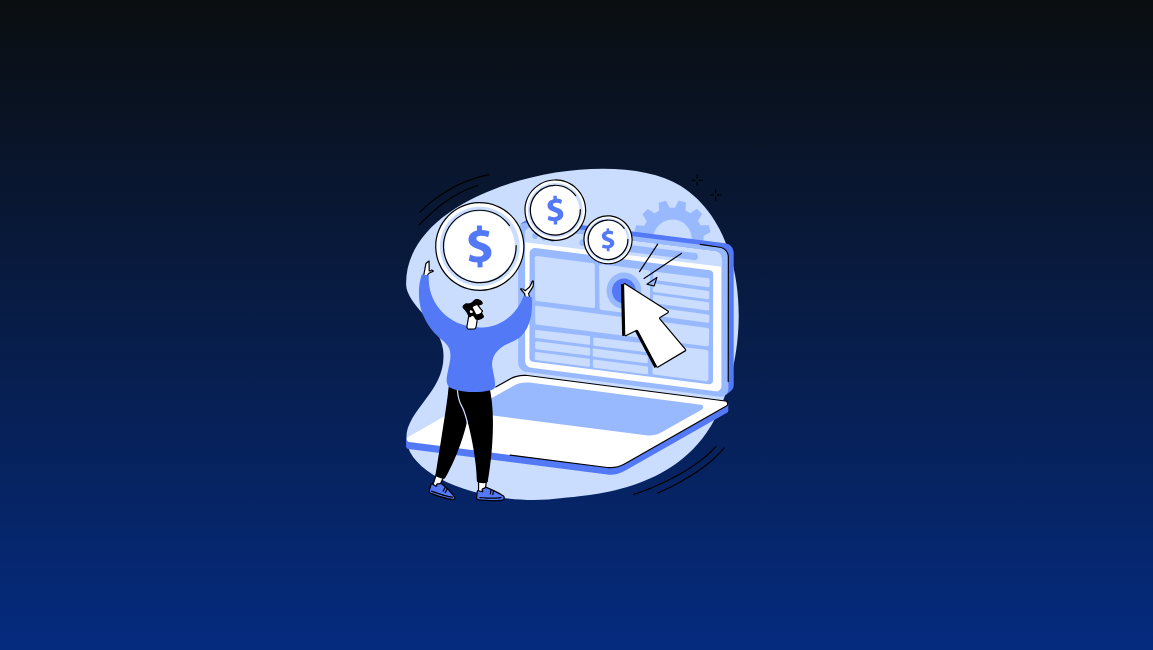If you haven’t tried popups for your Shopify store yet, we know you are thinking:
- Do popups actually work?
- Aren’t they annoying and rude?
- Won’t they drive visitors away and negatively affect sales?
- What about our motto to provide the best customer experience?
Those are all valid questions. But the fact is popups are a powerful marketing tool — that is, if they are correctly implemented. They can help you convert your visitors into ravenous customers and boost your sales.
As research has shown, they can boost your conversion rate by 14%.
In short, popups work. And therefore, the only question you should be asking is, “How do I make popups work for my brand?”
And the answer to that only, right question is in this article. Below, we share 15 tips to get more customers and sales using popups.
The 15 Tips to Grow Your Shopify Business with Popups
Tip #1: Add a Popup Builder App to Your Shopify Store
Unless you are a badass developer with a lot of time on your plate, coding a popup from scratch won’t cut it. Not only is this approach difficult and time-consuming, but it is also inefficient.
What to do, then? Add a popup builder app to your store!
There are lots of popup builder apps for Shopify. Adoric (our app) is one of them – you can add it for free and scale up from there as needed.
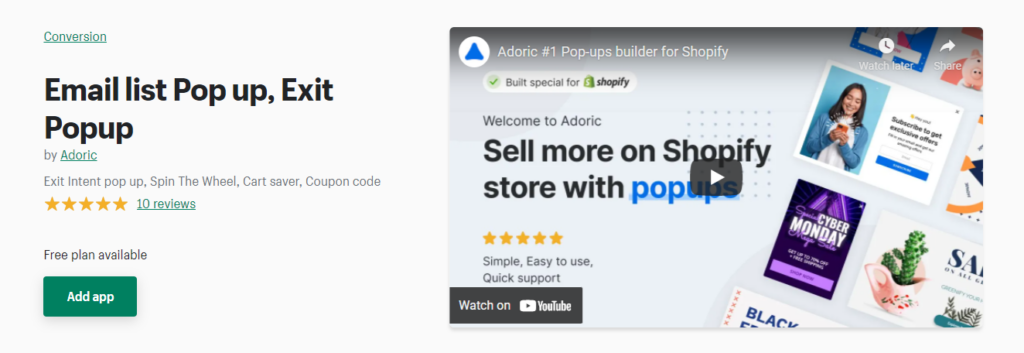
Adoric comes with an intuitive editor that helps you build elegant, stunning popups in minutes. It also has over 1000 templates that you can edit and customize to fit your need.
In addition to that, Adoric has lots of features and tools designed to help you create effective marketing campaigns. For example, it includes audience targeting, A/B testing, an analytic dashboard, and plug-and-play integrations with HubSpot, MailChimp, and other CRMs.
Tip #2: Make Your Popups Eye-Catching
Boring, generic popups hardly ever attract attention. Using them on your website will only drive away your visitors or subconsciously make them click the close (x) button.
As such, it’s important to put in the needed effort to make your popups attractive and eye-catching. The more attractive your popups are, the more attention they will get from your visitors.
Now tell us, which of the following two popups capture the most attention? Exactly!
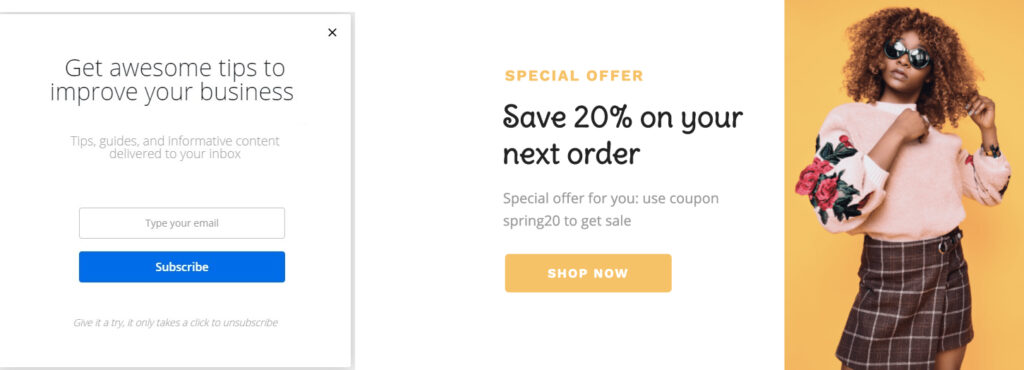
Tip #3: Use High-Quality Images and Strong Headings
It’s not enough to make your popups eye-catching; you equally need to make them compelling to make your visitors want to engage with them.
How can you make your popups compelling? By writing strong, concise, and emotion-triggering headings and using high-quality images.
Writing strong headings for your popups isn’t rocket science. One of the things you can do to create one is use power words.
Power words are words and phrases that evoke readers’ emotions. Some good examples include:
- Captivate
- Supercharge
- Easy
- Massive
- Spoiler
Tip #4: Show Your Popups at the Right Time
One of the main reasons people can’t make popups work is wrong timing.
So when is the right time to display your popup? When your visitors have engaged with your website.
And how do you know that visitor is engaged? Two main ways to know are:
-
- Scroll depth: If the visitor has scrolled down a certain distance on your web page, it’s a sign they are engaged. Use case: Show your newsletter popup on the blog pages when a reader scrolls past 60% of the article.
- Time spent: Engaged visitors tend to spend more time on the website for obvious reasons. Therefore, show your popup after a certain time, depending on the popup. Use case: Let’s continue with the blog example. If readers spend an average of 2 minutes on your articles, show the popup after 1 minute.
Tip #5: Use Exit-Intent Popups
Sometimes, the best time to show your popups is when visitors attempt to exit your website. This is because visitors on their way out from your website will likely not find your popup annoying + the upside is humongous — you can win back 10% to 15% of abandoning visitors with exit-intent popups like this one:
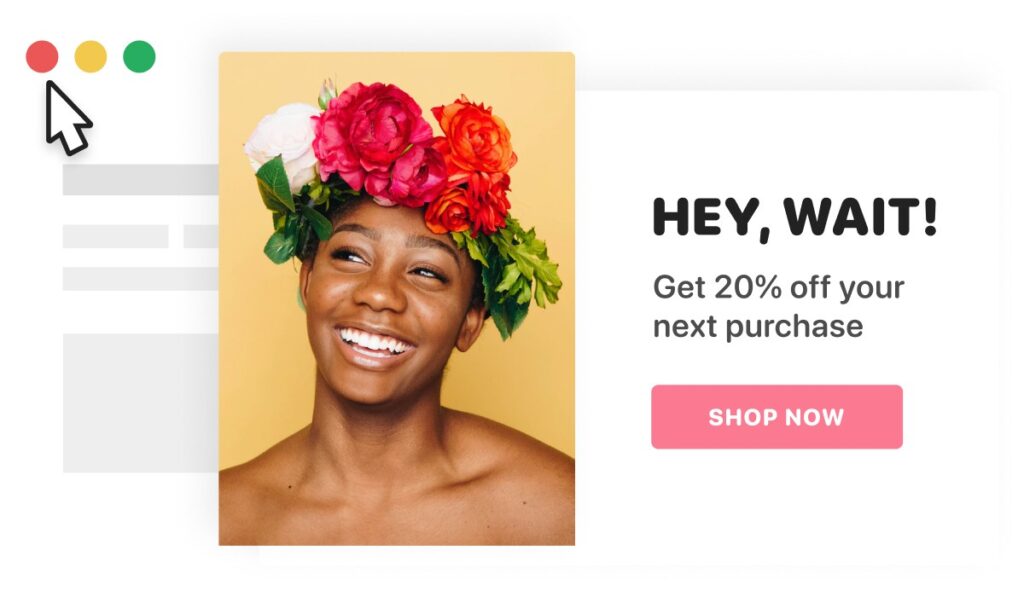
Tip #6: Add a Countdown Timer
Do you want to create a sense of urgency and get people to quickly take the desired action(s)? If yes, you need a countdown timer popup.
A countdown timer is a digital clock that counts down to a particular time in the future. The essence of using countdown timers in popups is to create urgency with your visitors and steer up what is known as FOMO (or fear of missing out) in them.
Here’s an excellent countdown time popup, for example:

Tip #7: Use Spin to Win Popups
Regular popups can sometimes be boring, no matter how attractive they might look. If you’ve been using regular popups on your Shopify website but haven’t seen any tangible results so far, it’s about time you tried using a spin-to-win/coupon wheel popup instead.
This type of popup gives visitors the chance to win coupons or discounts by spinning a wheel of fortune. They can then shop in your store with the coupons/discounts they win.
Here’s a good spin-to-win popup example:
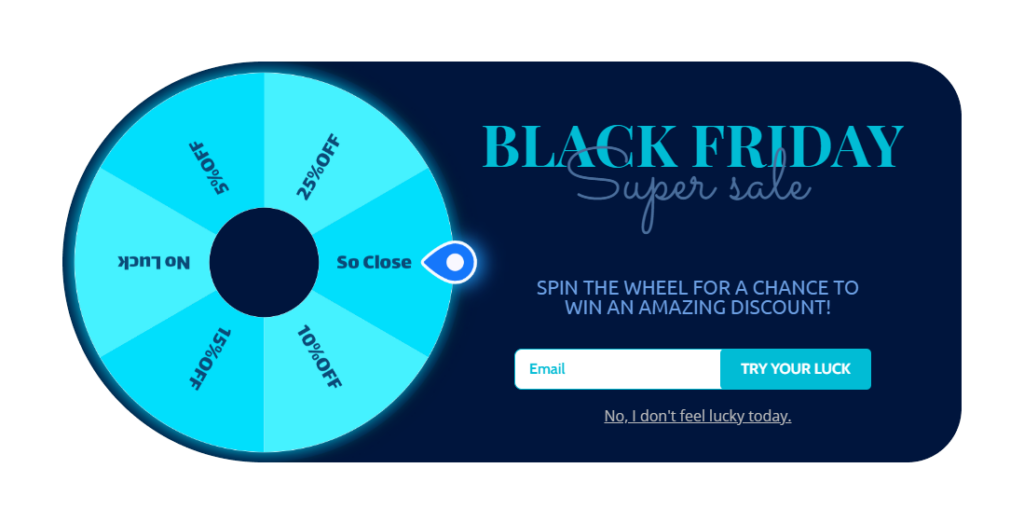
Tip #8: Use Multi-step Popups
If you want to collect more information about the visitor than just their name and email address, multi-step popups are your friend.
Multi-step popups, as the name suggests, are popups with more than one step. They look something like this:

Won’t your visitors get mad and exit your website by making them take multiple steps just to complete a popup? Well, it’s quite the opposite!
As Zeigarmik, a notable psychologist, observed, people will most likely finish whatever task they start. This is the reason why multi-step popups are effective.
Tip #9: Show Your Popups to the Right People
Not everyone will want to buy from you or subscribe to your newsletter. Know this and know peace.
The trick is to know the audiences that will most likely engage with your campaigns and segment them accordingly.
For example, you can segment your audience based on the language they speak, geolocation, type of device they use, and lots more.
Tip #10: Personalize Your Popups
These numbers tell a story:
- 80% of consumers are more likely to buy from a company that provides a tailored experience.
- 70% of consumers say that how well a company understands individuals’ needs impacts their loyalty.
- 71% of customers are frustrated by impersonal shopping experiences.
And the story is simple: If you want to win in the competitive ecommerce space, you need to personalize customer experiences as much as possible.
One good way to personalize your shoppers’ experience is by suggesting products they will find relevant based on their buying behavior and preferences.
Here’s an example of a product recommendation popup:

Tip #11: A/B Test Your Campaign
It can be tempting to remove popups from your website if you haven’t noticed any tangible results. Don’t – at least, not yet!
Instead, run an A/B test.
A/B testing refers to the process of testing different variations of a marketing element to see which version yields the best result.
For example, instead of discarding your popup altogether, you can change the heading, button color, text, image, popup timing, etc., to see if there are any meaningful improvements.
Even if your popups are doing well for you, you should try A/B testing new variations. If the new popup gives better results, great; if it doesn’t, keep the popup as it is.
Tip #12: Add a Video
You don’t always have to use texts and images for your popups. Try using a video.
You would be surprised how effective videos can be in helping you win more customers and sales with popups. After all, 72% of consumers say they prefer to learn about a product by watching a video.

Tip #13: Offer something
A simple “buy now” popup won’t motivate the visitor to make a purchase. Similarly, “Subscribe to our newsletter” won’t excite them to give their email.
You need to tie an obvious benefit to those actions for visitors to excitedly take them.
- If you want visitor information, you can use lead magnets. Lead magnets are freebies used to entice visitors to give their contact details. They can be free ebooks, video tutorials, PDFs, etc.
- If you want something else, show a popup with a benefit that influences them to take action. For example, if the visitor abandons the cart, show a “free shipping” popup because that’s the #1 reason why customers abandon the purchase.
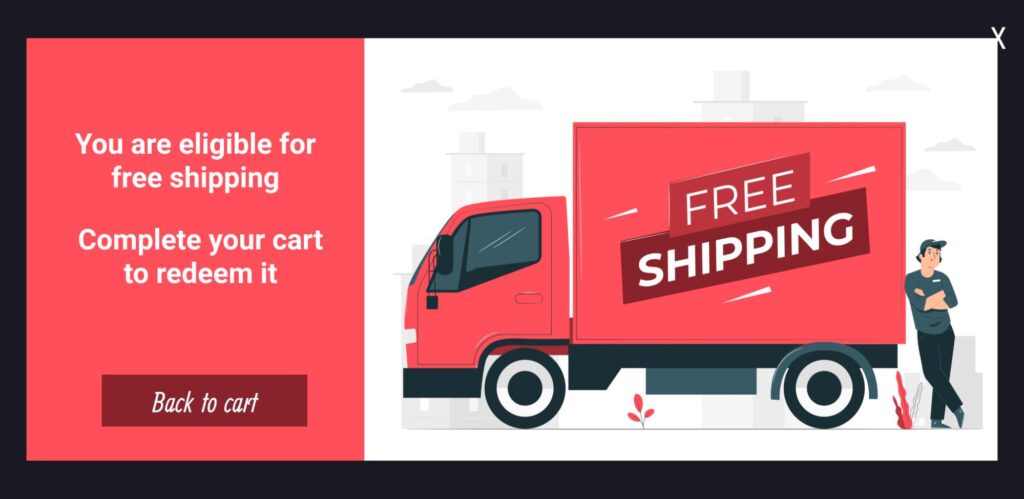
Tip #14: Use a Slide-in Display
If you feel your popups are too intrusive, try a slide-in display.
A slide-in display is a display modal that shows up from the corner of visitors’ screens. They take comparatively lesser space than front-and-center popups yet are attention grabbers. Here’s an example:

Just like the slide-in display, sticky bars (popups that stick at a particular place on the website, typically heading) are also less intrusive than the average popups.
Tip #15: Make Your Popups Mobile-Friendly
This is an obvious tip, but sadly, many businesses still don’t make their popups mobile-friendly.
If your popups aren’t mobile-friendly, you ruin the browsing experience and chase visitors away. In other words, you will lose sales.
All in All
Popups work. You just need to get them right. Follow the tips mentioned above and drive results for your Shopify store with popups!


